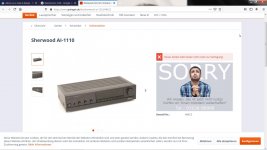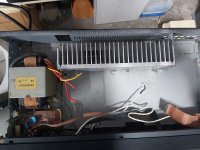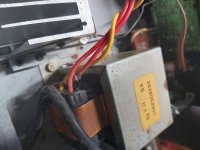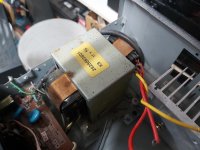Gilera, if the trafo has a lable on with its specifications take a photo and post it please. That will help determining if the trafo rating is suitable for what you want to do.
Kevin
Kevin
I'm guessing thread starter is totally confused right now 🙁 hope all this didn't scare him off into further audio diy.
Ha, no it all good. Thanks for all of the great suggestions.
The transformer is 32-0-32VAC (measured unloaded), so I was thinking of having separate boards for each channel.
The donor amp was a Sherwood AI-1110. I will take a couple of photos after work tonight showing the inside. The transformer does not have any specs shown on it and I can’t find any details online either from the manufacturer or the numbers written on it. Just has a sticker on the back of the chassis saying 230W. It was a surround sound amp with 50W RMS per main channel. It is has a decent internal heatsink and well ventilated chassis but now am thinking that even with fans the heatsink may not be enough given the high input voltage. If so I could modify the chassis to have large external heatsinks on the side.
Hi.
32 volts for hiraga is high, you could consider to go regulated that would lower volts to match hiraga and also clean up the dc, hiraga needs clean dc otherwise there will be audible hum.
A ripple eater like jlh would also lower voltage a few volts.
Don't forget heavy heatsinking.
The 32 volts mentioned are probably unloaded, loaded with 2-3 amps it should be a tad lower
Based on the advice, I have narrowed it down to JLH or Le Monstre if I can manage to get enough amps out at a lower regulated voltage to maintain Class A throughout most of the output power range. The amount of support and information available for the JLH would help, but the Hiraga sound get such good reviews.
The general impression is that the the Hiraga it a bit trickier to set up and get stable - is this correct?
Which of these 2 designs have more foolproof modern transistor replacements in terms of availability and circuit stability - or will I be looking to find matched pairs of the originally specified ones in either case?
Once I commit to a design, I will wade through the several hundreds of pages of the relevant thread to get up to speed before asking more questions.
Although this will be my first amp build from scratch, I would rather commit to something that will give me the best end result even if it takes me a long time and a lot of learning along the way. This forum is very supportive and it is a hobby to do in my spare time. The process is almost as rewarding as the end result for me. A few hours here and there to keep me sane without taking too much time out from my young family. I am just finishing a media streamer with a Class D 3e TPA3255 board + Khadas Tone Board DAC + raspberry pi. I made it from an old Sharp Tuner chassis and replaced the panels with aluminium sheet. This was mostly to cut my teeth in DIY audio and also for WAF. I would love something from the opposite end of the spectrum - old school Class A that I can build from scratch to compare it to (and use in Winter). I am even tempted to do it on perf board (probably not the ripple eater though).
Some of the links posted by OldDIY were very educational, I hadn't heard of some of thise designs.
If the overall idea is not completely absurd, then I will start with the power supply and deal with the heat as needed.
Regardless of whether I go JLH or Hiraga Monster:
1. Would it be reasonable to aim for say 27VDC out of the ripple eater if I want to maintain high enough amperage to keep Class A throughout most of the output range?
2. Would a good approach to get the voltage down be to use an LM317? The advantage that I see to the LM317 (apart from being able to accept the high input voltage) is that I could adjust the resistors to compensate for voltage loss due to smoothing e.g. via the ripple eater.
http://www.farnell.com/datasheets/1...MI24CemOSq6gIVlHwrCh0gAQO_EAQYASABEgJtzfD_BwE
I realise that the LM317 will likely get quite hot and could mount on the main heatsink.
This amazes me.. just below in DIY audio there is the Pass area.
Build one of the several ones listed. Fairly easy ALL the help you could hope for and there is yet to be an A amp that works/sounds better.
IF fixated on trying to recycle some crap Transformer ?? That's simply sad.
Buy a New suitable one.. Splurge the 50$ ! and get on with it.
Build one of the several ones listed. Fairly easy ALL the help you could hope for and there is yet to be an A amp that works/sounds better.
IF fixated on trying to recycle some crap Transformer ?? That's simply sad.
Buy a New suitable one.. Splurge the 50$ ! and get on with it.
IF fixated on trying to recycle some crap Transformer ?? That's simply sad.
Buy a New suitable one.. Splurge the 50$ ! and get on with it.
If necessary i will. My original question was is this necessary? Not very environmentally friendly or economical to throw a perfectly good transformer in the bin. I find that sad. Just because it puts out 32v does not make it crap. It looks like a well made transformer built for use in audio. I beleive it may perform better than the cheap generic toroidals that many people use.
Last edited:
You can measure the resistance of the secondary winding of the transformer with a multimeter.
You can load the secondary winding with a resistance of 30 ohms 150 watts (heater or electric kettle). See how the transformer feels - a voltage drop, heating, fire.
Sherwood has a weak transformer and heatsink made of thin aluminum tape.
You can load the secondary winding with a resistance of 30 ohms 150 watts (heater or electric kettle). See how the transformer feels - a voltage drop, heating, fire.
Sherwood has a weak transformer and heatsink made of thin aluminum tape.
Hi Gilera
I think people here try to help you save money in the way to invest on something they see from start that it don't work out. I took a look a the Sherwood Integrated amp.
Try to address that CLASS A for you a bit. In CLASS AB mode transformer delivers the power according to how much the user turns up the VOLUME CONTROL. Bias will be at max 100 / 200 Milliamp MAX, and this is already high. So that Transformer of the Sherwood will fit.
Now Class a is not that way. CLASS A draws from beginning when the POWER SWITCH is ON the full POWER . So that transformer of you will not be able to deliver that Power constantly, because the A cirquit does not CARE about your Volume Control how much it is open unless it's open all the way..Then and only then the AMP will be able to deliver its power without excessive heat or say less heat.
Now, to use a LM317 is not a bad Idea but it's max output is only 2 amps if I read the Manual correct. It wont last longer than 30 minutes and then you will need to exchange that regulator. If you with CLASS A try to get 10 Watts out of that Amplifier then you must input about 4 times the power you like to get at the output. I'm talking about the efficiency of 25% of the class a. which is already very high if you can achieve that. I do not know this JLH amplifier. But I know that for 10 Watts output you will need at least a 350VAC transformer for 1 Channel to be on the safe side. Not only the output gets hot, the draw of the Current for BIAS will also load the PSU, and this the Transformer.
I'm sure that transformer will a run a CLass AB just fine, but not a Class A.. May a 5 Watt and I think as soon you will connect that Class A even if its only 5 Watts the output voltage of at the end of the PSU will drop by 10 - 15volts without even have sound on the AMP.
Right now I'm building a Single End Class A with only 20 Watts. Transformer is "No cheap toroid" and it is 35-0-35 with 7.14AMP per Secondary winding. without the Class A 20 Connected I get 48 Volts with only 5millivolts Ripple. I use double Bridge and 22'000ufd Filter and another 12'000 ufd after the first filte Caps. As soon the Amp - And I'm talking about one Channel only- Voltage drops down to +- 44volts.. Now imagine your Transformer. This will only be possible if you use a Weak Class A but then also the output will show you that the Transformer is not suitable. You will not gain anything to regulate the voltage on that because it's limited by the Transformer itself.
If you Build a class a where current increases when opening the trottle *Volume* then this is no more a CLASS A.
The Case of that Sherwood, if also just for 10 Watts is far too small to handle two channels. About the Fans, OK you can do that but when listening on little volume but the fans are turning on highspeed because otherwise the cooling is not enough, exactly then you will sure try to find another way to have that cooled down to a normal Range.. Normal range for CLASS A without FAN is 80Degrees -100 Degrees Celcious and not 40 - 50. With 50 you already will find it HOT.
I do not say, do not build that, I just say before you build it with that in mind what you have, make sure that you don't waste time and money. Buy a suitable transformer and the Sherwood Tranformer and Case you can use to a later day when you build the Line drive which will not take that much current and size. Looking from that aspect to your Project, it's all a Win Win situation.. you can re-use that Sherwood AI-1100 and also invest a little money to get that Class A build.
I think people here try to help you save money in the way to invest on something they see from start that it don't work out. I took a look a the Sherwood Integrated amp.
Try to address that CLASS A for you a bit. In CLASS AB mode transformer delivers the power according to how much the user turns up the VOLUME CONTROL. Bias will be at max 100 / 200 Milliamp MAX, and this is already high. So that Transformer of the Sherwood will fit.
Now Class a is not that way. CLASS A draws from beginning when the POWER SWITCH is ON the full POWER . So that transformer of you will not be able to deliver that Power constantly, because the A cirquit does not CARE about your Volume Control how much it is open unless it's open all the way..Then and only then the AMP will be able to deliver its power without excessive heat or say less heat.
Now, to use a LM317 is not a bad Idea but it's max output is only 2 amps if I read the Manual correct. It wont last longer than 30 minutes and then you will need to exchange that regulator. If you with CLASS A try to get 10 Watts out of that Amplifier then you must input about 4 times the power you like to get at the output. I'm talking about the efficiency of 25% of the class a. which is already very high if you can achieve that. I do not know this JLH amplifier. But I know that for 10 Watts output you will need at least a 350VAC transformer for 1 Channel to be on the safe side. Not only the output gets hot, the draw of the Current for BIAS will also load the PSU, and this the Transformer.
I'm sure that transformer will a run a CLass AB just fine, but not a Class A.. May a 5 Watt and I think as soon you will connect that Class A even if its only 5 Watts the output voltage of at the end of the PSU will drop by 10 - 15volts without even have sound on the AMP.
Right now I'm building a Single End Class A with only 20 Watts. Transformer is "No cheap toroid" and it is 35-0-35 with 7.14AMP per Secondary winding. without the Class A 20 Connected I get 48 Volts with only 5millivolts Ripple. I use double Bridge and 22'000ufd Filter and another 12'000 ufd after the first filte Caps. As soon the Amp - And I'm talking about one Channel only- Voltage drops down to +- 44volts.. Now imagine your Transformer. This will only be possible if you use a Weak Class A but then also the output will show you that the Transformer is not suitable. You will not gain anything to regulate the voltage on that because it's limited by the Transformer itself.
If you Build a class a where current increases when opening the trottle *Volume* then this is no more a CLASS A.
The Case of that Sherwood, if also just for 10 Watts is far too small to handle two channels. About the Fans, OK you can do that but when listening on little volume but the fans are turning on highspeed because otherwise the cooling is not enough, exactly then you will sure try to find another way to have that cooled down to a normal Range.. Normal range for CLASS A without FAN is 80Degrees -100 Degrees Celcious and not 40 - 50. With 50 you already will find it HOT.
I do not say, do not build that, I just say before you build it with that in mind what you have, make sure that you don't waste time and money. Buy a suitable transformer and the Sherwood Tranformer and Case you can use to a later day when you build the Line drive which will not take that much current and size. Looking from that aspect to your Project, it's all a Win Win situation.. you can re-use that Sherwood AI-1100 and also invest a little money to get that Class A build.
Attachments
Thanks for your explanation hpro. That does all make sense and I think you have answered my original question and saved me time and effort. I will save this for another project and plan my class A build without it in mind.
In class A 10W, a heatsink as you need for each transistor (((
In your case, you can assemble an AB / B class amplifier with a power of 2 * 50 watts from a kit. For example MX50, or klone Naim\NAP140 etc.
In your case, you can assemble an AB / B class amplifier with a power of 2 * 50 watts from a kit. For example MX50, or klone Naim\NAP140 etc.
....abount 45V DC ... Why cant these amps just be set to lower amps and higher voltage?....
The idea in class A is the amplifier sucks the maximum current it could ever need, and passes some part of that to the load.
44V DC implies 22V peak. 22V peak in 8 Ohms is 2.75A peak. The average is at-least half of 2.75A, or 1.375 Amps. The idle dissipation is then 44V*1.375A or 60.5 Watts. Twice for stereo. 121 Watts. ALL the time. You do get near 30 Watts audio output.
Your heatsink won't sink that 121 Watts of power without high-velocity blowers.
For the same power output, class A needs Seven times the dissipation of a B/AB design. And for speech/music, round-up, because the AB amp runs cool most of the time, less degradation of transistors.
Add 120mm Noctua PWM fans at low speed and it should handle 60w no problem. They are silent at the lowest speed. 13dB is lower than ambient household sounds at night.
I've used some 120mm fans from arctic cooling, the have a 20cm cable with a temperature probe in, self regulating unit
Last edited:
You can ALWAYS dial the standing current in a class A amp down. It means you operate for less of the output in class A, but the heat dissipation goes down.
So, if your heat sinks are on the small side, just run the standing current at a lower level.
So, if your heat sinks are on the small side, just run the standing current at a lower level.
Add 120mm Noctua PWM fans at low speed and it should handle 60w no problem. They are silent at the lowest speed. 13dB is lower than ambient household sounds at night.
This.
Regarding Class A designs in general (not considering my transformer for a second). Everyones response to the voltage/current issue seem to include reference to the major issue of heat. If a specific amp did put out 60W heat dissipation per channel, wouldn't one of these on each side sort it out?
H0545 300 x 75 x 46mm Diecast Heatsink - Altronics
0.37degC/W = 22 degrees above ambient for 120W.
$60AUD for heatsinking but any Class A is going to require a resonable investment in this area (+ PSU). One (Noctua) fan costs about this much. Am I missing something?
As an aside, you get some old i7 CPUs that were rated up at 90W and these didn't have overly elaborate heat sinks - just a reasonable fan in a well ventilated case. I have a Noctua NH-L9i (92mm) fan in a mini ITX case with an Ivy Bridge i7 and it is completely silent unless your are 30cm away and it never gets hot even when running a stress test. 2 of these type fans would make for a very compact Class A build but as I said above would likely cost more that good heat sinks.
I appreciate that CPUs aren't really designed to run flat out all the time and don't in most applications so i'm not comparing apples with apples here...
Last edited:
It is advisable to install each transistor on a separate radiator, and isolate the radiators.
Insulating gaskets for transistors increase thermal resistance and impair cooling.
But different options are possible.
Insulating gaskets for transistors increase thermal resistance and impair cooling.
But different options are possible.
It is advisable to install each transistor on a separate radiator, and isolate the radiators.
Why is this? I would have thought that once thermal equilibrium was acheived that it wouldn't matter if the transistors were all at the same temp provided it was within their rating.
Thermal resistances are connected in series (summed). Crystal case, (gasket), case-radiator, radiator-environment
- Home
- Amplifiers
- Solid State
- Advice on a Class A design



